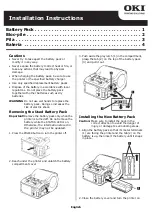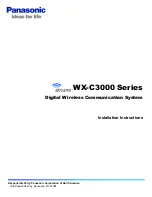
Page
5/53
- Batteries installed in a device, or which are electrically connected to other components.
• To avoid short-circuits between the banana plugs fitted to the charge leads, please always connect
the charge leads to the charger first, and only then to the battery to be charged. Reverse the
sequence when disconnecting.
• As a basic rule always check that the charge quantity is approximately the same as you expected
after the charger has indicated that the pack is fully charged. This is a simple method of detecting a
problem reliably and in good time, should the charge process be terminated prematurely for any
reason. The likelihood of premature termination varies according to many factors, but is at its highest
with deep-discharged packs, low cell counts and particular cell types which are known to cause
problems.
• We recommend that you carry out a series of test charges to satisfy yourself that the automatic
termination circuit is working perfectly. This applies in particular when you are charging packs
consisting of a small number of cells. If the cells feature has a poorly defined voltage peak, the
charger may fail to detect the fully charged state.
• Before charging please check: have you selected the appropriate charge program for the battery?
Have you set the correct charge or discharge current? Have you set the important cut-off voltage
when charging Ni-Cd and Ni-MH packs? Are all connections firm, or is there an intermittent contact
at any point in the circuit? Please bear in mind that it can be dangerous to fast-charge batteries. For
example, if there is a brief interruption due to an intermittent contact, the result is inevitably a
malfunction such as a restart of the charge process, which would result in the pack being massively
overcharged.
• Be careful! A battery could explode or burn, if the charger does have a fault or if the user
does choose the wrong charging program and parameters.
A-3. GENERAL NOTES ON USING THE CHARGER
Charging batteries
When a battery is charged, a particular quantity of electrical energy is fed into it. The charge quantity is
calculated by multiplying charge current by charge time. The maximum permissible charge current
varies according to the battery type, and can be found in the information provided by the battery
manufacturer.
It is only permissible to charge batteries at rates higher than the standard (slow) current if they are
expressly stated to be rapid-charge capable. The STANDARD CHARGE CURRENT is 1/10 (one
tenth) of the cells’ nominal capacity (e.g. for a 1.7 Ah pack the standard charge current is 170 mA).
• Connect the battery to be charged to the charger output sockets using a suitable charge lead (red =
positive terminal, black = negative terminal).
• Be sure to read the information provided by the battery manufacturer regarding charging methods,
and observe the recommended charge currents and charge times. Do not attempt to fast-charge
batteries unless they are expressly stated to be suitable for the high currents which this charger
Summary of Contents for 6444
Page 17: ...Seite 13 60 ...
Page 77: ...Page 13 53 ...
















































